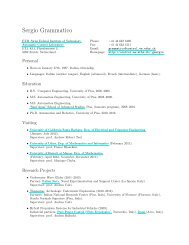Linear System Theory Fall 2012 final exam Questions
Linear System Theory Fall 2012 final exam Questions
Linear System Theory Fall 2012 final exam Questions
Create successful ePaper yourself
Turn your PDF publications into a flip-book with our unique Google optimized e-Paper software.
<strong>Linear</strong> <strong>System</strong> <strong>Theory</strong> <strong>Fall</strong> <strong>2012</strong> <strong>final</strong> <strong>exam</strong><br />
<strong>Questions</strong><br />
Exercise 1 (25%)<br />
(1) [14%] For y(t) ∈ R consider the dynamical system<br />
¨y(t) + 2 ˙y(t) − 4y(t) + y(t) 3 = 0.<br />
(a) [4%] Using x1(t) = y(t) and x2(t) = ˙y(t) as states and y(t) as an output write the<br />
system in state space form. Is it linear? What is the system dimension?<br />
(b) [4%] Find all equilibrium points of the system.<br />
(c) [6%] <strong>Linear</strong>ize the system around all its equilibria and determine the stability of the<br />
resulting linear systems.<br />
(2) [11%] For x(t) ∈ Rn , consider the linear time varying system<br />
<br />
−1 e2t ˙x(t) = x(t).<br />
0 −1<br />
<br />
1<br />
(a) [6%] What is the solution for initial condition ? Verify that the solution for initial<br />
0<br />
<br />
0 et−e−t condition is 2<br />
1 e−t <br />
. From these, determine the state transition matrix.<br />
(b) [5%] Determine stability of the equilibrium ˆx = 0.<br />
Exercise 2 (25%)<br />
Consider the Hilbert space (R n , R, 〈·, ·〉) with the inner product defining the 2-norm. Let A(t) ∈<br />
R n×n and for x(t) ∈ R n consider the linear time varying system<br />
˙x(t) = A(t)x(t).<br />
(a) [10%] Consider the adjoint system ˙˜x(t) = −A T (t)˜x(t) with ˜x(t) ∈ R n . Show that for all<br />
t, t0 ∈ R<br />
〈˜x(t), x(t)〉 = 〈˜x(t0), x(t0)〉.<br />
(b) [5%] Assume now that A(t) = A T (t) for all t ∈ R; recall that in this case the eigenvalues of<br />
A(t) are real and its eigenvectors are orthogonal. Show that there exists a matrix E(t) ∈ R n×n<br />
with E(t) T E(t) = E(t)E(t) T = I and a diagonal matrix Λ(t) ∈ R n×n such that<br />
A(t) = E(t) T Λ(t)E(t).<br />
(c) [10%] Assume again that A(t) = A T (t) and that there exists µ > 0 such that the eigenvalues<br />
of A(t) satisfy<br />
λ ≤ −µ < 0, for all t ∈ R and all λ ∈ Spec[A(t)].<br />
Show that the equilibrium ˆx = 0 of the linear system ˙x(t) = A(t)x(t) is exponentially stable.<br />
Is the same true for the adjoint system? Hint: Differentiate the function V (t) = 〈x(t), x(t)〉<br />
and use your answer to Part (b).<br />
1
Exercise 3 [25%] Consider the linear time invariant system<br />
˙x(t) = Ax(t) + Bu(t) (1)<br />
with x(t) ∈ Rn , u(t) ∈ Rm , A ∈ Rn×n and B ∈ Rn×n . Fix a time interval [0, t] for some t ≥ 0 and<br />
consider the evolution of the system (1) starting at initial condition x(0) = x0 ∈ Rn .<br />
(a) [8%] Consider the function R : L2 ([0, t], Rm ) −→ Rn defined by<br />
t<br />
R(u(·)) = e At x0 +<br />
0<br />
e A(t−τ) Bu(τ)dτ<br />
for u(·) : [0, t] −→ R m . Under what conditions is this function linear?<br />
(b) [7%] Consider the range of the function R of part (a) defined by<br />
Range(R) = x ∈ R n | ∃u(·) ∈ L 2 ([0, t], R m ) : R(u(·)) = x .<br />
Show that there exists u(·) : [0, t] −→ Rm steering (x0, 0) to (x1, t) if and only if x1 ∈<br />
Range(R). Is Range(R) a subsapce of Rn ?<br />
(c) [10%] Consider now the controllability Gramian<br />
W (t) =<br />
t<br />
e<br />
0<br />
A(t−τ) BB T (e A(t−τ) ) T dτ.<br />
Show that W (t) is a solution to the matrix differential equation<br />
d<br />
dt W (t) = AW (t) + W (t)AT + BB T<br />
for an appropriate initial condition. What is the initial condition? Is the solution unique?<br />
Hint: You may assume the Leibnitz rule<br />
d<br />
dt<br />
b(t)<br />
a(t)<br />
f(t, τ)dτ =<br />
b(t)<br />
a(t)<br />
∂f(t, τ)<br />
dτ + f(t, b(t))<br />
∂t<br />
db(t)<br />
dt<br />
− f(t, a(t))da(t) .<br />
dt<br />
Exercise 4 [25%]<br />
The company Design and Control Ltd. hired an engineer in the 1950’s to develop a new product.<br />
The engineer placed enough sensors and actuators to obtain a 3-input, 3-output system. The state<br />
space equations he came up with were:<br />
⎡<br />
˙x(t) = ⎣<br />
−1 0 0<br />
0 1 0<br />
0 1 −1<br />
⎤<br />
⎡<br />
⎦ x(t) + ⎣<br />
1 0 0<br />
0 1 0<br />
0 0 1<br />
⎤<br />
⎡<br />
⎦ u(t), y(t) = ⎣<br />
1 0 0<br />
0 1 0<br />
0 0 1<br />
⎤<br />
⎦ x(t).<br />
To ensure fast response of the system he then designed a state feedback controller so that the closed<br />
loop system has all its eigenvalues equal to −5. Then he went into retirement.<br />
(a) [10%] In an effort to reduce production costs, the CTO of Design and Control Ltd. hired you<br />
to reduce the number of actuators used in the product. Design a new state feedback controller<br />
that achieves the same convergence rate but with fewer actuators. What is the minimum<br />
number of actuators you need?<br />
(b) [7%] The Head of Marketing pointed out that, as long as the system is stable, customers only<br />
care about the convergence rate of x3(t). Is it possible to design a state feedback controller<br />
that achieves the same convergence rate for x3(t), but uses even fewer actuators? If so, provide<br />
a design.<br />
(c) [8%] The CFO noticed that sensors are a bigger part of production costs than actuators.<br />
Given that you only care about stability and the convergence rate of x3(t) you believe you can<br />
reconstruct the states necessary for your controller in part (b) by measuring only one of them.<br />
Which state would that be? Justify your answer.<br />
2



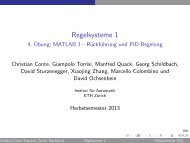
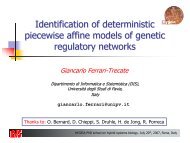
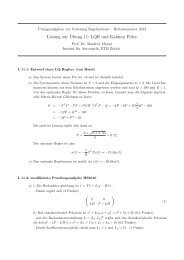

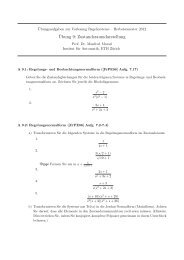
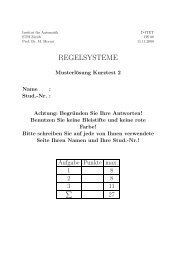

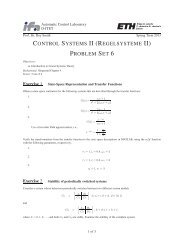
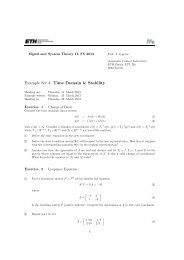

![Convex Optimization: [0.5ex] from Real-Time ... - ETH Zürich](https://img.yumpu.com/18678007/1/190x143/convex-optimization-05ex-from-real-time-eth-zurich.jpg?quality=85)
